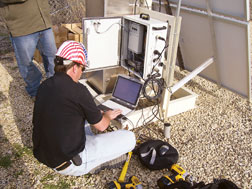Anatural-gas pipeline operator in the Midwest is testing a new monitoring system that not only sends an alert if there is an impact on the pipe but can even warn operators of dangers nearby.
 Southern star central gas pipeline
|
In the first U.S. use of the technology, Southern Star Central Gas Pipeline Inc., Wichita, Kan., installed three ThreatScan monitors on 13 miles of 760-psi, 16-in.-diameter pipeline in a densely populated area, says Amy Jo McKean, the company’s lead engineer on the project. The goal is ambitious. “Impact detection is good, but we want to get to the right-of-way encroachment level,” she says.
Results are promising. On July 31, shortly after calibration, the system picked up sounds of a backhoe digging about 40 ft from the line.
The system was developed by GE Pipeline Solutions from technology acquired in June from a French firm, 01Db Metravib, which created it for aviation. It monitors by listening to sounds carried in pipeline contents, says Jeff Johnson, a GE ThreatScan specialist. GE Energy Financial Services is a part owner of Southern Star.
 Southern star central gas pipeline Sensitive. Solar-powered hydrophone system plugs into pipe aboveground.
|
On pipelines, 10-in.-long hydrophones are inserted into the stream at above-ground valves normally located at regular intervals for safety and control. Sensor spacing depends on the sound transmission qualities of the contents. It can range from three to five miles for crude oil to as much as 50 miles for high-pressure gas. “Viscosity is the number-one factor,” Johnson explains.
The hydrophones and processors filter out normal sounds but flag unusual ones, like impacts and the low-frequency rumbling of excavators. By comparing data from two sensors, the system can locate the sound source with an accuracy of 2% of sensor spacing, says Johnson. Soil conditions do not affect performance much, but hard, dry soil works best, he says.
 Ge oil & Gas ’ PII Pipeline Solutions
|
McKean, who worked for GE Pipeline’s Integrity Services Group before moving to Southern Star, says she brought the technology with her. “I knew enough about ThreatScan to take it to management,” she says. “It’s an insurance policy...you don’t need it till you need it, and it was it a hard sell.” But, she adds, “The event on July 31 was a huge positive.”
McKean says the project has been enjoyable. “If it fails, it’s your fault; if it succeeds, it’s a company project” she says. “Right now it’s a company project.” She says impact detection was immediate, but it took two months to calibrate for proximity detection.
 Ge oil & Gas ’ PII Pipeline Solutions
|
Southern Star’s system has solar-powered stations that transmit data via satellite to GE monitoring and processing centers in Houston and Florence, Italy. McKean says she opted for solar power to make it easy to relocate the sensors later. Johnson says a similar system will cost $50,000 to $70,000 per unit, which includes ownership of hardware, installation, commissioning and two years of monitoring.
There have been false alarms, McKean says, but Manuel Terranova, GE Integrity Services general manager, says the rate is less than 9%. And on Aug. 7, ThreatScan scored again on a pipeline in Houston owned by Spectra Energy Corp. “A guy was scraping grasses off the right-of-way with a bulldozer,” Johnson says. “He wasn’t even digging.”




Post a comment to this article
Report Abusive Comment